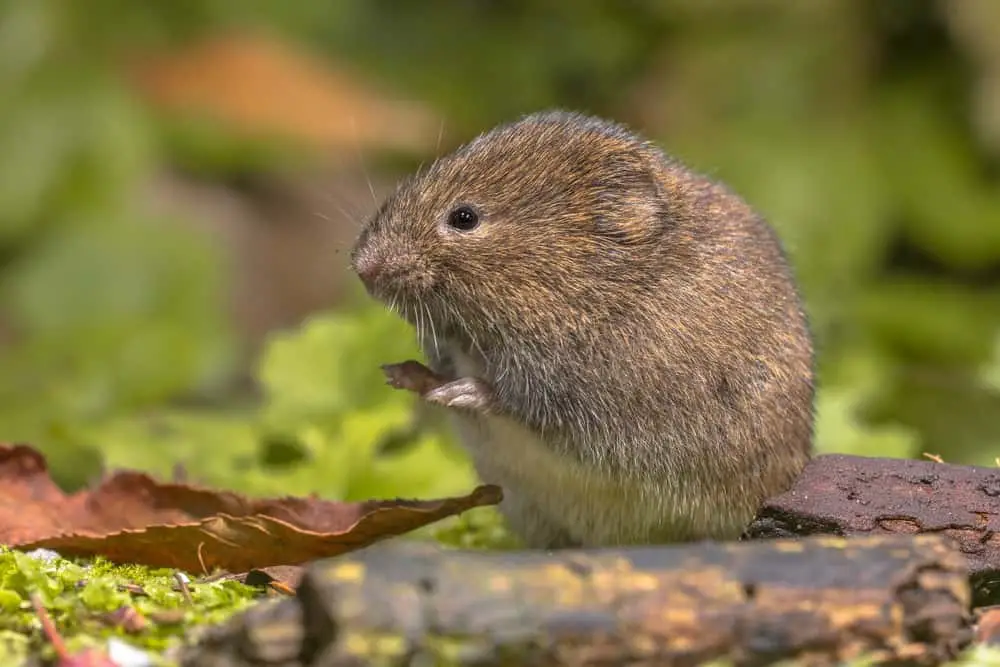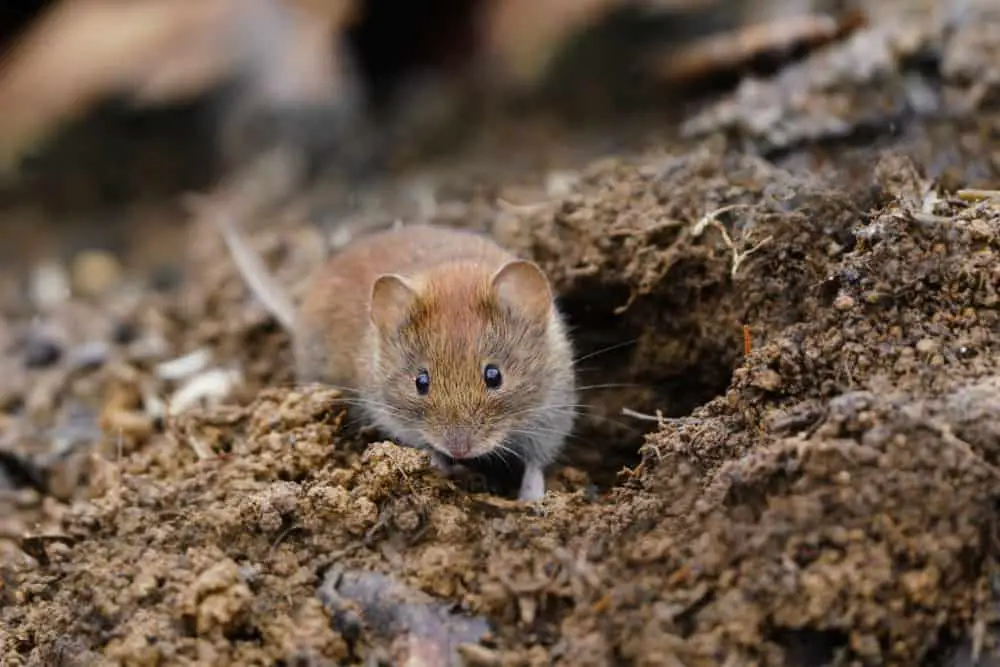Voles are small rodents of the subfamily Arvicolinae, found in North America and Europe. They are commonly known for their extensive burrowing habits which can be destructive to agricultural crops. This article will explore the characteristics of vole species, their behavior, distribution, and ecology.
The family Cricetidae contains over 100 species of voles worldwide, divided into five genera: Microtus (the largest genus), Ellobius, Myopus, Phenacomys, and Arborimus. Voles range in size from 3-12 inches long and weigh between 1/2 – 5 ounces.
Most species have short tails that are not visible when viewed from above; additionally they possess fur-lined external cheek pouches used for carrying food back to their nests or underground tunnels.
Most voles inhabit open grassy areas with a thick ground cover such as meadows and fields where they feed on various plant material including leaves, stems, fruits, seeds and roots. Some species also feed on insects or other small animals for additional protein sources.
Voles build elaborate networks of shallow underground tunnels throughout their habitat which provide protection against predators while providing them easy access to both food resources and potential mates during breeding seasons.

Definition Of Vole
Voles are a species of rodent belonging to the family Cricetidae. They are small mammals that can range in size from 2-9 inches long, with an average weight of 3 ounces or less. Voles have short tails and rounded ears, along with soft fur covering their bodies. Their coloration varies depending on the region they live in, but most vole colors include shades of brown and gray.
The definition of a vole is relatively broad as there are over 155 identified species within this genus. These rodents are found across Europe, Asia, and North America, primarily inhabiting grassy areas such as meadows and fields. In order for voles to survive and thrive in these habitats, they must consume a variety of food sources including seeds, fruits, roots, insects, and other vegetation.
Voles also possess unique behavior patterns that set them apart from other members of their family. For example, many species create intricate pathways during nesting season while others will dig burrows to store food items throughout the year. This combination of dietary preferences and behaviors allows voles to inhabit many different types of environments around the world.
Anatomy And Appearance
Voles are small mammals that belong to the family of Arvicolidae. They have short, stocky bodies and their anatomy can vary depending on species. Generally, they have a thick pelage covering most of its body which can be grey or brown in color. The length of their fur depends upon the area where it inhabits; for example, those living in colder climates tend to have longer hair than those found in warmer environments.
The size variation among vole species is also significant as some individuals may reach up to 16 cm while others only grow 8 cm long from head-to-tail tip. When looking at their tail, one will notice that it has a hairy texture but no scaly appearance like other rodents, such as mice and rats. This trait gives voles an advantage when it comes to climbing trees since scales can make them slippery surfaces for these animals to grip onto.
The skull structure of voles is relatively large compared to other members of the rodent family due to its need for efficient hearing and sharp vision when navigating through grasslands and meadows looking for food sources and avoiding predators. In terms of behavior, many vole species use burrows as shelters during cold winter months or when times get tough with limited food supply available.
To summarize, voles are unique critters with distinct physical characteristics ranging from fur length and pelage coloration to body size variations and shapely tails adapted for successful tree climbing abilities. Their skulls provide them with enhanced sensory capabilities that help navigate difficult terrains filled with potential threats from both natural enemies and humans alike seeking out new sources of protein for consumption purposes.
Habitat And Range
Voles inhabit a wide range of habitats, including grassland and burrowing habitats. They are found in Eurasia as well as North America, occupying temperate to subarctic biomes in both regions. Vole range extends from western Alaska eastward across the northern tier of Canada and into Greenland. In Europe, vole ranges extend from Norway south through Germany to Spain.
The habitat preferences of voles vary depending on the species; some prefer open grasslands while others gravitate towards denser vegetation such as shrubs or trees. Burrowing habitats provide shelter for voles from predators and extreme weather conditions, with many species constructing extensive tunnels beneath snow cover during winter months. Some voles may also dig elaborate networks of underground chambers for food storage and hibernation purposes.
In terms of climate tolerance, most voles can survive relatively cold temperatures but only tolerate mild heat before becoming inactive or migrating to cooler areas. Many species remain active year-round provided there is an adequate food supply available which consists mainly of seeds, roots, insects and other small invertebrates. Therefore it is important that their natural habitat encompasses sufficient resources in order to sustain them throughout the year.
Overall, voles occupy various diverse environments ranging from temperate forests to alpine tundra ecosystems; they require suitable substrate types such as soil or sand for burrowing activities along with abundant sources of food and nesting materials near their living quarters in order to thrive under different climatic regimes around the world.
Diet And Feeding Habits
Voles have a varied diet that consists of both plant material and insects. They are omnivorous, which means they eat both plants and animals. Plant material makes up the majority of their diet, including grasses, roots, stems, leaves, fruit, nuts and seeds. Voles also feed on small invertebrates such as earthworms, snails and slugs. Additionally, voles commonly consume other rodents like mice and shrews.
The feeding habits of voles vary depending upon the season or region in which they inhabit. In cold climates with snow cover during winter months, they primarily feed on green vegetation found beneath the snow layer or inside trees and shrubs near the ground level. When temperatures warm up during late spring to summertime months, voles switch to eating herbaceous material located at higher elevations above the snow line if available.
Vole populations tend to increase when food sources are abundant within their habitat range; however it is important for them to limit their activity so as not to deplete all resources present. Therefore they must store enough food in order to survive periods where food becomes scarce due to weather patterns or seasonal changes. During these times of limited resource availability voles will migrate from areas where there is no food back towards sites with more plentiful amounts of plant materials and insect prey items for sustenance.
Behaviour And Social Structure
Voles exhibit a range of complex behaviours that are important to their social structure. Burrowing behaviour is seen in the majority of vole species, with extensive tunnel systems created for habitat and shelter.
Territorial behaviour is also observed in many species, which involves scent marking to indicate boundaries between territories. Parental care from both parents has been observed in some species such as Microtus agrestis, where it was found that there was no difference in parental care depending on gender.
Group dynamics have been studied extensively within voles due to the importance of understanding how these interactions shape population ecology. Studies have highlighted the role of alarm calls when predators are present as well as other vocalisations used during intraspecific communication.
Aggressive encounters were also identified by researchers, wherein spontaneous aggression often occurred without any prior cues or provocation.
The complexity and diversity of behaviours exhibited by voles provides insight into their ecological roles within different habitats. Such knowledge assists conservation efforts focused on long-term protection and management of vole populations across various regions worldwide.
It is imperative that research continues to be conducted so that further information can be revealed about their behavioural strategies for survival and reproduction within changing environments.

Reproduction And Lifespan
Studies of vole behaviour and social structure have provided a basis for exploring the species’ reproductive patterns. Understanding how voles reproduce is important because it helps to explain their complex life cycles, as well as contributes to conservation efforts. In this section, we will examine the mating behaviour, gestation period, litter size, breeding cycle and life expectancy of voles.
Voles typically mate during spring and early summer months in temperate climates; however, some species may also breed year-round in tropical regions with ample resources available. Mating occurs after an elaborate courtship ritual involving aggressive vocalizations from both sexes and periods of sniffing at each other’s faces or grooming one another.
After mating takes place, female voles can enter estrous again within 24 hours if they are not impregnated. Gestation lasts approximately 21 days followed by litters that range between two to six offspring per birth depending on environmental factors such as food availability and weather conditions.
Vole populations usually reach peak density around autumn due to successful reproduction over the course of the warm season. The typical lifespan of adult voles ranges between 12 – 18 months although some individuals may live up to two years in ideal environments with adequate nutrition levels.
Mortality rates increase significantly throughout winter when resources become scarce since competition for food increases exponentially among larger numbers of animals living in close proximity.
This research has shown that vole reproduction is governed by seasonal changes which influence its population dynamics across different habitats worldwide. These findings suggest that studying vole behavior alongside its reproductive patterns could help inform strategies for better management practices which would promote healthy ecosystems while preserving individual species diversity in all types of habitats.
Conservation Status
The conservation status of vole species is a significant cause for concern. Voles are classified as endangered species due to population decline, habitat destruction and climate change. These pressures have resulted in fragmented populations and the potential local extirpation of certain species.
There are several efforts being made to conserve voles, including:
- Captive breeding programs
- Reintroduction initiatives
- Expansion and protection of suitable habitats
- Monitoring of existing populations
- Management strategies such as predator control
Research has shown that without reliable conservation efforts, there will be further declines in vole numbers across their range. The introduction of nonnative predators, lack of available food sources and fragmentation of remaining populations all contribute to this problem.
Although recent advances in research methods provide valuable insights into how best to manage these threats, much more must be done if we are to ensure the long term survival of these species into the future.
Conclusion
Voles are a diverse group of rodents that inhabit an array of habitats around the world. They possess a wide range of anatomical features and exhibit various behaviours, which they use to find food sources and establish social hierarchies. Voles reproduce quickly, with some species reaching sexual maturity within weeks of birth. This rapid reproductive rate has enabled them to survive in changing environments despite their small size.
The conservation status for voles varies amongst different species, with some subspecies listed as endangered or vulnerable due to habitat loss or predation from non-native animals. In order to protect these species it is important for humans to become aware of their presence and take steps towards preserving their natural habitats.
Furthermore, research should be conducted into the ecology and behaviour of these fascinating creatures in order to better understand how they interact with their environment and other species living alongside them.
Overall, voles are an ecologically important part of many terrestrial ecosystems across the globe. Through furthering our understanding of these animals we can continue to work towards conserving them for future generations to appreciate and enjoy.

